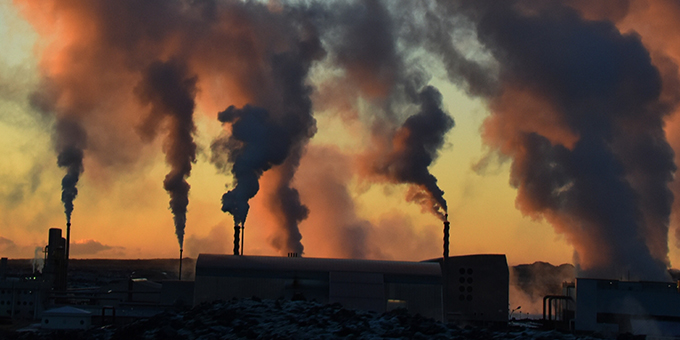The EU has introduced an Emissions Trading System, the EU ETS. The system is based on common EU rules that apply to all EU member states as well as Norway, Iceland, and Liechtenstein. The purpose of emissions trading is to reduce greenhouse gas emissions. Companies and entities responsible for emissions are allocated emission allowances for a trading period of four to five years. During this period, companies that emit less carbon dioxide than their allowances permit can either save their surplus for the following year or sell their rights to a company that has used up its allowances. Emissions trading is an important tool in meeting the EU’s commitments under the Kyoto Protocol.
The idea is that emissions will decrease when the price of emission allowances exceeds the cost of reducing emissions. This can be achieved, for example, through changes in production or improved technology. The number of allocated emission allowances is also reduced from year to year.
In Sweden, around 750 facilities are included in the system. Most of these are energy producers such as heating plants, but other examples include the pulp and paper industry, iron and steel works, and cement factories.
Operators subject to the emissions trading scheme are required to monitor their greenhouse gas emissions. Companies’ reports on carbon dioxide emissions and applications for allocation of emission allowances must be verified by an independent accredited verifier. These verifiers are also referred to as verification bodies and are accredited by Swedac.
There are also verification regulations for emissions from fuel loaded in Sweden and used for international shipping. These are governed by EU Regulations (EU) 2015/757 and (EU) 2023/2917. Verification of emissions from maritime transport is carried out by accredited verification bodies.
Contact person at Swedac for questions related to accreditation in greenhouse gas verification is Kaarlo Book.
Under “Requirements and Guidance Documents” is a list of the documents relevant to greenhouse gas verification for different areas.
Additional information can be found on the European Commission’s website:
- Monitoring, reporting and verification of EU ETS emissions
- Reducing emissions from the shipping sector
Requirements and guidance documents - EU/ETS Verification of greenhouse gas emissions from fixed installations
Specific documents for the accreditation scheme
Requirements to be met for accreditation to be granted:
Instructions and guidelines for meeting accreditation requirements:
Accreditation and Verification Regulation (AVR): Guidance and templates (EU) 2019/331 – Commission Delegated Regulation (EU) 2019/331 of 19 December 2018 determining transitional Union-wide rules for harmonised free allocation of emission allowances pursuant to Article 10a of Directive 2003/87/EC of the European Parliament and of the Council EA-6/03 M:2022 – EA document for accreditation of Verification Bodies for the purpose of EU ETS Directive IAF MD 6:2024 – Application of ISO 14065:2020 ISO 14066:2023 – Competence requirements for teams validating and verifying environmental information ISO 14064-3:2019 – Specification with guidance for the verification and validation of greenhouse gas statementsGeneral documents for the conformity assessment procedure
Requirements to be met for accreditation to be granted:
STAFS 2020:1 – Swedac´s Regulations and General Guidelines on Accreditation
Documents providing guidance for compliance with accreditation requirements
SWEDAC DOC 20:1 – Swedac´s policy for reference to accreditationRequirements and guidance documents - EU/ETS Verification of greenhouse gas emissions from maritime transport
Specific documents for the accreditation scheme
Requirements to be met for accreditation to be granted:
Instructions and guidelines for meeting accreditation requirements:
(EU) 2016/1928 – Commission Implementing Regulation (EU) 2016/1928 of 4 November 2016 on determination of cargo carried for categories of ships other than passenger, ro-ro and container ships pursuant to Regulation (EU) 2015/757 of the European Parliament and of the Council on the monitoring, reporting and verification of carbon dioxide emissions from maritime transport (EU) 2023/2449 – Commission Implementing Regulation (EU) 2023/2449 of 6 November 2023 laying down rules for the application of Regulation (EU) 2015/757 of the European Parliament and of the Council as regards templates for monitoring plans, emissions reports, partial emissions reports, documents of compliance, and reports at company level, and repealing Commission Implementing Regulation (EU) 2016/1927 EA-6/03 M:2022 – EA document for accreditation of Verification Bodies for the purpose of EU ETS Directive IAF MD 6:2024 – Application of ISO 14065:2020 ISO 14066:2023 – Validating and verifying environmental information ISO 14064-3:2019 – Requirements specification with guidance for validation and verification of greenhouse gas reportsGeneral documents for the conformity assessment procedure
Requirements to be met for accreditation to be granted:
Documents providing guidance for compliance with accreditation requirements
SWEDAC DOC 20:1 – Swedac´s policy for reference to accreditation

